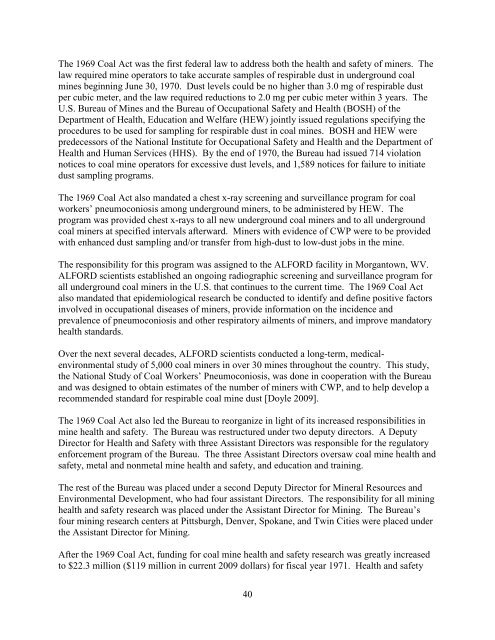One Hundred Years of Federal Mining Safety and Health Research
One Hundred Years of Federal Mining Safety and Health Research
One Hundred Years of Federal Mining Safety and Health Research
- No tags were found...
Create successful ePaper yourself
Turn your PDF publications into a flip-book with our unique Google optimized e-Paper software.
The 1969 Coal Act was the first federal law to address both the health <strong>and</strong> safety <strong>of</strong> miners. The<br />
law required mine operators to take accurate samples <strong>of</strong> respirable dust in underground coal<br />
mines beginning June 30, 1970. Dust levels could be no higher than 3.0 mg <strong>of</strong> respirable dust<br />
per cubic meter, <strong>and</strong> the law required reductions to 2.0 mg per cubic meter within 3 years. The<br />
U.S. Bureau <strong>of</strong> Mines <strong>and</strong> the Bureau <strong>of</strong> Occupational <strong>Safety</strong> <strong>and</strong> <strong>Health</strong> (BOSH) <strong>of</strong> the<br />
Department <strong>of</strong> <strong>Health</strong>, Education <strong>and</strong> Welfare (HEW) jointly issued regulations specifying the<br />
procedures to be used for sampling for respirable dust in coal mines. BOSH <strong>and</strong> HEW were<br />
predecessors <strong>of</strong> the National Institute for Occupational <strong>Safety</strong> <strong>and</strong> <strong>Health</strong> <strong>and</strong> the Department <strong>of</strong><br />
<strong>Health</strong> <strong>and</strong> Human Services (HHS). By the end <strong>of</strong> 1970, the Bureau had issued 714 violation<br />
notices to coal mine operators for excessive dust levels, <strong>and</strong> 1,589 notices for failure to initiate<br />
dust sampling programs.<br />
The 1969 Coal Act also m<strong>and</strong>ated a chest x-ray screening <strong>and</strong> surveillance program for coal<br />
workers’ pneumoconiosis among underground miners, to be administered by HEW. The<br />
program was provided chest x-rays to all new underground coal miners <strong>and</strong> to all underground<br />
coal miners at specified intervals afterward. Miners with evidence <strong>of</strong> CWP were to be provided<br />
with enhanced dust sampling <strong>and</strong>/or transfer from high-dust to low-dust jobs in the mine.<br />
The responsibility for this program was assigned to the ALFORD facility in Morgantown, WV.<br />
ALFORD scientists established an ongoing radiographic screening <strong>and</strong> surveillance program for<br />
all underground coal miners in the U.S. that continues to the current time. The 1969 Coal Act<br />
also m<strong>and</strong>ated that epidemiological research be conducted to identify <strong>and</strong> define positive factors<br />
involved in occupational diseases <strong>of</strong> miners, provide information on the incidence <strong>and</strong><br />
prevalence <strong>of</strong> pneumoconiosis <strong>and</strong> other respiratory ailments <strong>of</strong> miners, <strong>and</strong> improve m<strong>and</strong>atory<br />
health st<strong>and</strong>ards.<br />
Over the next several decades, ALFORD scientists conducted a long-term, medicalenvironmental<br />
study <strong>of</strong> 5,000 coal miners in over 30 mines throughout the country. This study,<br />
the National Study <strong>of</strong> Coal Workers’ Pneumoconiosis, was done in cooperation with the Bureau<br />
<strong>and</strong> was designed to obtain estimates <strong>of</strong> the number <strong>of</strong> miners with CWP, <strong>and</strong> to help develop a<br />
recommended st<strong>and</strong>ard for respirable coal mine dust [Doyle 2009].<br />
The 1969 Coal Act also led the Bureau to reorganize in light <strong>of</strong> its increased responsibilities in<br />
mine health <strong>and</strong> safety. The Bureau was restructured under two deputy directors. A Deputy<br />
Director for <strong>Health</strong> <strong>and</strong> <strong>Safety</strong> with three Assistant Directors was responsible for the regulatory<br />
enforcement program <strong>of</strong> the Bureau. The three Assistant Directors oversaw coal mine health <strong>and</strong><br />
safety, metal <strong>and</strong> nonmetal mine health <strong>and</strong> safety, <strong>and</strong> education <strong>and</strong> training.<br />
The rest <strong>of</strong> the Bureau was placed under a second Deputy Director for Mineral Resources <strong>and</strong><br />
Environmental Development, who had four assistant Directors. The responsibility for all mining<br />
health <strong>and</strong> safety research was placed under the Assistant Director for <strong>Mining</strong>. The Bureau’s<br />
four mining research centers at Pittsburgh, Denver, Spokane, <strong>and</strong> Twin Cities were placed under<br />
the Assistant Director for <strong>Mining</strong>.<br />
After the 1969 Coal Act, funding for coal mine health <strong>and</strong> safety research was greatly increased<br />
to $22.3 million ($119 million in current 2009 dollars) for fiscal year 1971. <strong>Health</strong> <strong>and</strong> safety<br />
40
















